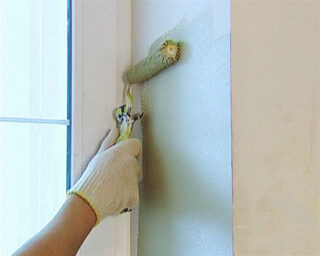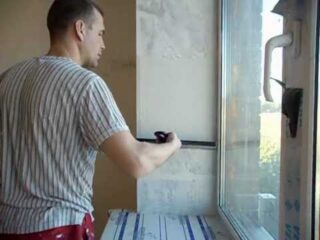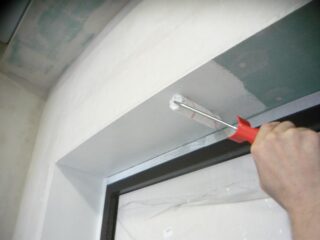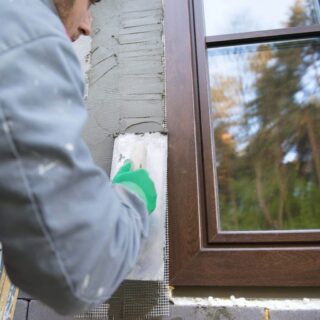Installation or replacement of windows entails additional plastering or plasterboard installation. However, such measures are not enough, since the surface needs protection and aesthetics. For this, paint is used for window slopes. Before starting work, prepare the tools and material, and also learn the technology for applying the pigment.
Criteria for choosing paint for finishing slopes

When choosing a paint for window slopes, it is recommended to take into account the surface condition during the cold season. The lower frame elements are exposed to moisture, which leads to the appearance of fungus. The best options for preventing mold are acrylate and latex dyes. Their composition is resistant to environmental influences.
For budget repairs, washable oil-based paints for window slopes, which include drying oil, are suitable. The resulting protective layer resists moisture, creates a glossy finish and is well cleaned of dirt. You should choose well-known brands, because after 10 years, cracks may appear on the surface.
The paint is selected in accordance with the criteria:
- decorative finish;
- resistance to moisture, UV radiation and mechanical damage;
- strength and durability;
- resistance to detergents;
- non-toxic composition;
- compliance with operational requirements.
However, expensive formulations do not always lead to the expected results if the painting technology is violated. Prepare the surface, treat the slopes with antiseptic solutions and a moisture-proof primer. Only with this approach can it be guaranteed that the pigment does not peel off after a year and will delight in appearance.
If you purchased paint without drying oil, dilute the mixture yourself with this substance. The painted surface will acquire a hard coating, will not have a toxic odor and will dry quickly after use. Suitable for indoor and outdoor work.
List of tools and materials

Having chosen the composition of the paint, prepare the tools and additional materials. Having the necessary equipment at hand speeds up the staining process and leads to positive results.
Set of tools:
- narrow brush and short-haired roller on foam rubber;
- small tray for painting;
- masking tape;
- primer;
- latex gloves;
- solvent;
- sponges, rags.
The pigment is applied only on a flat surface. If there are any defects on the wall, remove them using putty, plaster and / or drywall. Choose a roller for painting a small size, since a large-sized tool is inconvenient to work with. A short-nap roller will help prevent splashing and smudges on the treated surface.
If the inside of the frame is made of wood, use a light-colored paintwork or clear varnish.
Surface preparation

Proper preparation is the key to success. Examine the surface for irregularities and dents from different angles. It is recommended to do this in the morning and in the evening, so you can see all the flaws. The revealed defects are eliminated with putty.
If you do not remove grease stains with solvent before finishing, they will show through on the new coating.
After inspection and preparation, the surface is cleaned of dust with soapy water.If the slopes are old, use sandpaper or medium grit sandpaper. For an even paint application, pre-treat the slopes with a primer. This will prevent the appearance of flaws on the surface that were missed during inspection. For priming, you will need a roller and a 5 liter container. After application, wait for complete drying - 1.5-2 hours. When finished with processing, you can paint the slopes.
If the primer gets on the plastic or glass unit, immediately remove it with a damp sponge. Cover the window sill with polyethylene.
Slope painting technology
Regardless of the type of surface to be painted, cover the frames with masking tape. To do this, cut a strip of the appropriate length and glue it carefully. Smooth pasting allows you to avoid staining the window, since after removing the paint is difficult to wash.
Prepare the tools and tray before use - check if the roller fits its dimensions. Wear closed clothing, shoes, and latex gloves. If you use oil paint, the respirator will prevent intoxication of the body. Use plastic goggles to protect your eyes. After that, you can start finishing.
Hypoallergenic water-based paint is used for slopes if the windows are kept dry. Due to its composition, the mixture dries quickly. Take care of the surface with a soft sponge dipped in soapy water.
Drywall

Sand the surface with an abrasive paper and then vacuum the surface. Place perforated aluminum or plastic corners on the outer corners. After stripping, treat the slopes with a deep penetration primer.
Plasterboard slope painting technology:
- Open the jar and mix the contents thoroughly. Pour a small amount into the tray. Start painting at the joints and corners, then work over to the top of the slope and sides. In hard-to-reach places, use a thin brush.
- After painting the corners, take a roller and process the main surface. It is not recommended to carry out in one place several times - this entails the formation of smudges and stains.
- The first coat dries for 20-30 minutes depending on the type of paint and the thickness of the coating. After the specified time, process the surface a second time. Proceed in a similar way: joints and corners with a brush, the upper and main parts with a velor roller.
- After finishing painting, remove the masking tape. If this is not done right away, it will be difficult to rip it off the frame after drying.
High-quality paint dries no more than 4 hours, but it is recommended not to expose the surface to mechanical stress during the day.
Painting in the summer heat is fraught with rapid drying and the presence of stripes from a roller or brush.
Plaster

Before work, clean the surface of the slopes, prepare tools and materials. Cover the window frame with masking tape. Cover the window sill with plastic wrap. Remove traces of polyurethane foam with a stationery or construction knife.
External slopes are plastered with cement putty only. For outdoor painting, it is better to choose epoxy compounds.
If defects are found on the plaster, remove part of the coating and fill with fresh mortar until a flat wall is formed. This ensures that the paint is evenly applied. After using the plaster, wait 24 hours until it is completely dry. After 24 hours, apply the primer to the wall. Then prepare the paint for the window slopes on the plaster - open the jar and stir the composition thoroughly.
Step-by-step instruction:
- Use a narrow brush to process the joints, corners. Use a roller to paint the main surface.
- For a beautiful finish and last longer, apply two coats - the second after the first is completely dry.
- Do not make random movements with a roller or brush, as these strokes will appear after 12 hours.
- When finished, release the construction tape from the frames.If you try to remove after complete drying of the paintwork, there is a risk of peeling of the coating on the slopes.
It is forbidden to dry the treated surface with a hairdryer, since this entails a rapid destruction of the coating. Control the temperature in the room, avoiding humidity, dampness, drafts.








